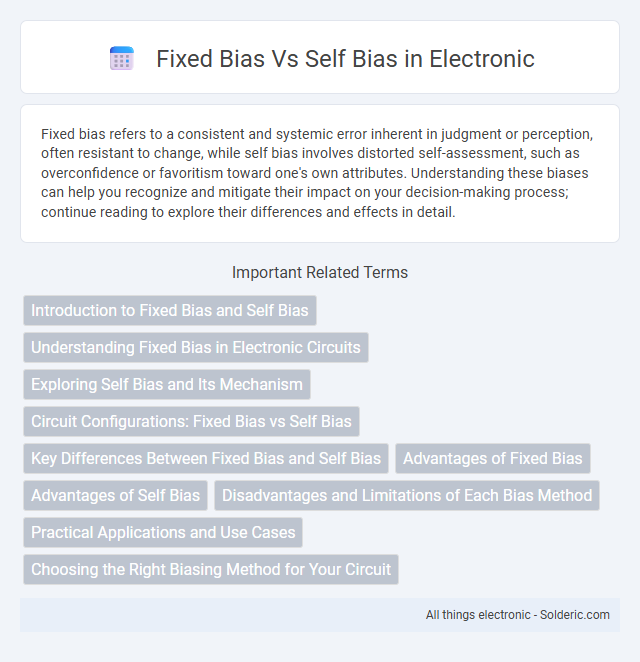Fixed bias refers to a consistent and systemic error inherent in judgment or perception, often resistant to change, while self bias involves distorted self-assessment, such as overconfidence or favoritism toward one's own attributes. Understanding these biases can help you recognize and mitigate their impact on your decision-making process; continue reading to explore their differences and effects in detail.
Comparison Table
| Feature | Fixed Bias | Self Bias |
|---|---|---|
| Definition | Bias voltage set by a fixed resistor connected to the power supply. | Bias voltage generated through the voltage drop across a resistor in the emitter circuit. |
| Stability | Less stable due to variations in transistor parameters or temperature. | More stable as it provides negative feedback reducing parameter variations. |
| Components Required | One resistor for biasing (base resistor). | Resistor in emitter (emitter resistor) plus base biasing resistor. |
| Thermal Runaway | Prone to thermal runaway due to lack of feedback control. | Resists thermal runaway by stabilizing operating point. |
| Complexity | Simple, easy to design. | More complex due to additional components and feedback. |
| Common Use | Basic biasing where precision is not critical. | Amplifier circuits requiring stable operating points. |
Introduction to Fixed Bias and Self Bias
Fixed bias circuits use a separate resistor to provide a constant base current regardless of transistor variations, ensuring predictable performance in amplifiers. Self bias, or emitter bias, employs a resistor in the emitter leg to stabilize the operating point by creating negative feedback, improving thermal stability. Understanding these biasing methods helps you design more reliable and efficient transistor circuits.
Understanding Fixed Bias in Electronic Circuits
Fixed bias in electronic circuits involves applying a constant voltage to the base of a transistor through a resistor, establishing a steady operating point that enhances signal amplification stability. This method offers simplicity and ease of implementation but may suffer from variations due to temperature changes and transistor parameter fluctuations, affecting circuit reliability. Understanding your circuit's fixed bias configuration helps optimize performance by ensuring proper transistor operation within safe and effective limits.
Exploring Self Bias and Its Mechanism
Self bias refers to the cognitive tendency where individuals process information in a way that favors their own perspective, often enhancing memory retention and decision-making related to self-relevant stimuli. The underlying mechanism of self bias involves neural networks, including the medial prefrontal cortex, which prioritizes self-referential information by increasing attention and encoding efficiency. Understanding self bias reveals how personal relevance influences cognitive processing differently from fixed bias, which is based on static, external rules or stimuli.
Circuit Configurations: Fixed Bias vs Self Bias
Fixed bias circuits utilize a direct connection between the base resistor and the power supply, providing a constant base current independent of transistor variations, which can lead to less stability. Self bias configurations incorporate a resistor in the emitter leg, creating negative feedback that stabilizes the operating point against temperature and transistor parameter changes. This intrinsic feedback in self bias circuits enhances bias stability and makes them preferable for consistent performance in amplifiers.
Key Differences Between Fixed Bias and Self Bias
Fixed bias involves an external voltage source applied to the transistor's base, providing stable and predictable operating conditions, while self bias relies on the transistor's own emitter current and a resistor to establish the bias voltage. The fixed bias circuit typically offers simpler design but suffers from poor thermal stability, whereas self bias improves thermal stability by compensating for variations in transistor parameters. Your choice between fixed and self bias depends on the desired balance between circuit stability and design complexity.
Advantages of Fixed Bias
Fixed bias offers stable and predictable operating points in transistor circuits, enhancing reliability and reducing the need for frequent recalibration. This biasing method minimizes the effects of temperature variations and transistor parameter changes, ensuring consistent performance. You benefit from simplified circuit design and easier troubleshooting due to its straightforward configuration.
Advantages of Self Bias
Self bias offers improved stability in transistor circuits by reducing the influence of temperature variations and transistor parameter changes, leading to consistent operating points. It enhances thermal runaway prevention by providing negative feedback through the emitter resistor, which automatically adjusts the bias current. This method simplifies circuit design and increases reliability in analog applications such as amplifiers.
Disadvantages and Limitations of Each Bias Method
Fixed bias in devices often leads to temperature instability and requires precise resistor selection, limiting circuit reliability and flexibility under varying environmental conditions. Self bias, while offering better thermal stability by using feedback from the device's own operating point, can cause reduced gain and slower response times due to dependency on operating currents. Both methods present trade-offs between stability, complexity, and performance, constraining their application based on specific circuit requirements.
Practical Applications and Use Cases
Fixed bias transistors provide consistent operating points ideal for amplifier circuits requiring stability under varying conditions, ensuring predictable performance in audio and radio frequency applications. Self bias configurations offer improved thermal stability and adaptability, making them suitable for temperature-sensitive devices and feedback control systems in power regulation. Your choice between fixed and self bias affects circuit reliability and efficiency across communication, signal processing, and control environments.
Choosing the Right Biasing Method for Your Circuit
Selecting the appropriate biasing method depends on factors like temperature stability, component tolerance, and circuit simplicity. Fixed bias offers straightforward implementation but suffers from poor thermal stability and is sensitive to transistor parameter variations. Self bias, or emitter bias, provides improved stability by incorporating negative feedback through the emitter resistor, making it ideal for circuits requiring consistent operating points under varying conditions.
fixed bias vs self bias Infographic

 solderic.com
solderic.com